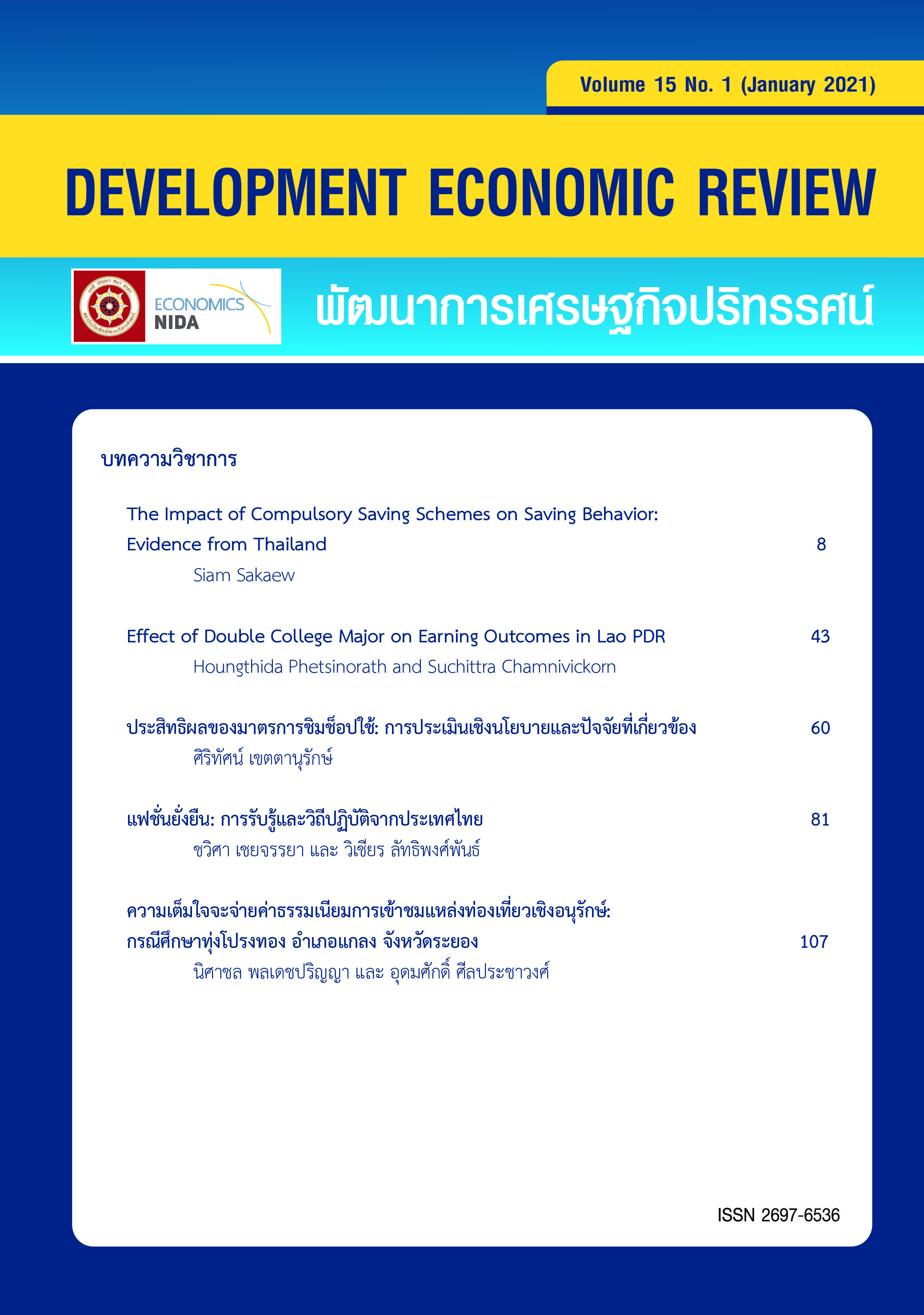The Effectiveness of Shim Shop Shai Policy: Policy Evaluation and its Determinants
Keywords:
Policy Effectiveness, Logistic Regression, Shim Shop Shai PolicyAbstract
The purpose of this research is to evaluate the effectiveness of the Shim Shop Shai policy by using the descriptive statistics, binary logistic regression and ordered logistic regression models. The results show that the percentages of people who registered for the Shim Shop Shai policy were 49.67. The probability of the registration is significantly affected by individual characteristics such as gender, age, income, and factors related to government registration system. Women, middle age and elderly people, and low-income people statistically increase the effectiveness of the policy. Nevertheless, the results indicate that female registrants achieve the policy objectives at a low level. To reach a higher level of achievement, the government should enhance public understanding by increasing public relations and improve the payment application for convenience.
References
Department of Information, Office of the Permanent Secretary of the Ministry of Finance. (2562). "Shim Shop Shai" Spending via the Second g-Wallet Receiving 15% Cash Back up to 4,500 Baht Easy Top-up from any Commercial Banks Conveniently Spending Everywhere, except the Residence Registration Area. Ministry of Finance News, 117/2562. (In Thai)
กุณธีรา ตรีสุราช. (2553). การวิเคราะห์ผลกระทบของโครงการเช็คช่วยชาติ 2,000 บาท ต่อการใช้จ่ายบริโภคในจัหวัดนครพนม. วิทยานิพนธ์เศรษฐศาสตร์มหาบัณฑิต, สาขาวิชาเศรษฐศาสตร์,มหาวิทยาลัยสุโขทัยธรรมาธิราช.
Kuntira Srisurach. (2553). An Analysis of the Effect of 2,000 Baht Cash Handout on the Consumption in Nakhonphanom Province. School of Economics, Sukhothai Thammathirat Open University. (In Thai)
ชญาดา วรรณะลี. (2556) การวิเคราะห์ผลกระทบของนโยบายกระตุ้นเศรษฐกิจที่มีต่อการเจริญเติบโตทางเศรษฐกิจของไทย. วิทยานิพนธ์เศรษฐตาสตรมหาบัณฑิต, คณะเศรษฐตาสตร์, มหาวิทยาลัยเชียงใหม่.
Chayada Wannalee. (2556). Impacts of Economic Stimulus Policies on Economic Growth of Thailand. Faculty of Economics, Chiangmai University. (In Thai)
ตีรณ พงศ์เมฆพัฒน์. (2550) เศรษฐศาสตร์มหภาค: ทฤษฎี นโยบายและการวิเคราะห์สมัยใหม่ (พิมพ์ครั้งที่ 4). กรุงเทพฯ: โรงพิมพ์แห่งจุฬาลงกรณ์มหาวิทยาลัย.
Teerana Bhongmakapat. (2550). Macroeconomics: Theory Policy and Modern Analysis (4th ed). Bangkok: Chulalongkorn University Press. (In Thai)
ธนนิจ ยินดีฉัตร. (2553). การใช้จ่าย "เช็ดช่วยชาติ 2,000 บาท" ต่อการกระตุ้นเศรษฐกิจของจังหวัดนครพนม. วิทยานิพนธ์เตรษฐศาสตรมหาบัณฑิต, สาขาวิชาเศรษฐศาสตร์ มหาวิทยาลัยสุโขทัยธรรมาธิราช.
Tananit Yindeechurt. (2553). Expenditure of Cheque Chuay Chart 2,000 Baht and Economic Stimulus in Nakhon Phanom Province. School of Economics, Sukhothai Thammathirat Open University. (In Thai)
นพวัชร์ อติวรรณพัฒน์ (2552). การวิเคราะห์ผลกระทบของโครงการเช็ดช่วยชาติต่อการใช้จ่ายบริโภคของประเทศไทย. วิทยานิพนธ์เศรษฐศาสตรมหาบัณฑิต สาขาวิชาเศรษฐศาสตร์, มหาวิทยาลัยสุโขทัยธรรมาธิราช.
Noppawat Atiwannapat (2552). An Analysis of the Impacts of the Cheque Chuaichart Program on Consumption Expenditure in Thailand. School of Economics, Sukhothai Thammathirat Open University. (In Thai)
พัทธมน ช่างสกล. (2553). การประเมินโครงการเช็คช่วยชาติ 2,000 บาทของรัฐบาลต่อผู้ร่วมโครงการในเขตนิคมอุตสาหกรรมภาคเหนือ จังหวัดลำพูน. วิทยานิพนธ์เศรษฐศาสตรมหาบัณฑิต, คณะเศรษฐศาสตร์ มหาวิทยาลัยเชียงใหม่.
Pattamon Changsagol. (2553). Performance Evaluation of Government 2,000 Baht Cash Handout Project of Participants in Northemn Region Industrial Estate, Lumphun Province, Faculty of Economics, Chiangmai University. (In Thai)
รติมา คชนันทน์ (2560) ยุทธศาสตร์การค้า ทางรอดเศรษฐกิจไทย. บทความวิชาการ Hot Issue, สำนักวิชาการ สำนักงานเลขาธิการสภาผู้แทนราษฎร: 1-6.
Ratima Gajanandana. (2560). Trade Strategy Thailand E conomic Survival. Academic Hot Issue, National Assembly Library of Thailand, the Secretariat of the House of Representatives:1-6. (In Thai)
รัตนา สายคณิต. (2556) หลักครษฐตาสตร์ แ มหครษฐคาสตร์ (พิมพ์ครั้งที่ 5). กรุงเทพฯ: โรงพิมพ์แห่งจุหลงกรณ์มหาวิทยาลัย.
RattanaSaikanit. (2556). Principle of Economics /: Macroeconomics (5th ed.). Bangkok: Chulalongkorn University Press. (In Thai) สำนักนโยบายและยุทธตาสตร์ทางการดั กระทรวงพาณิชย์. (2562) สืบดัน 22 กุมภาพันธ์ 2563, จาก https://www.ditp.go.th/ditp_web61/article_sub_view.php?filename=contents _attach/5774121577412.pdf&title=577412&cate= 1434&d=0
Trade Policy and Strategy Office, Ministry of Commerce. (2019). Retrieved from https:/www.ditp.go.th/ditp_web61/article_sub_view.php?filename =contents_attach/577412/577412.pdf&title=577412&cate=1434&d=0.
Auerbach, A.J. & Gorodnichenko, Y. (2012). Measuring the Output Responses to Fiscal Policy. American Economic Journal: Economic Policy, 4(2): 1-27.
Bachman, R. & Sims, E. (2012). Confidence and the Transmission of Government Spending Shocks. Journal of Monetary Economics, 59(3): 235-249.
Beetsma, R., Giuliodori, M. & Klaassen, F. (2008). The Effect of Public Spending Shock on Trade Balances and Budget Deficits in the European Union. Journal of the European Economic Association, 6(2-3): 414-423.
Canzoneri, M., Collard, F. Dellas, H. & Deba, B. (2015). Fiscal Multipliers in Recession. The Economic Journal, 126(590): 75-108.
Cochran, W.G. (1977). Sampling Techniques (3rd ed). New York: John Wiley & Sons. Harmon, S.K. & Hill, J. (2003). Gender and Coupon Use. Journal of Product & Brand Management, 12(3): 166-179.
Pope, E. (2005). Cashing in It: Getting Ready for A World without Money. Chicago: Moody Publisher.
Riera-Crichton, D., Vegh, C. & Vuletin, G. (2014). Procyclical and Countercyclical Fiscal Multipliers: Evidence from OECD Countries. Working Paper No. 20533, National Bureau of Economics Research.
Sereetrakul, W., Wongveeravuti, S., & Likitapiwat, T. (2013). Gender Differences in Saving and Spending Behaviors of Thai Students. Research in Education, 90(1): 68-81.
Thaler, R.H. & Sunstein, C.R. (2008). Nudge: Improving Decisions about Health, Wealth, and Happiness. London: Yale University Press.
Ilzetzki, E., Mendoza, E.G. & Vegh, C.A. (2013). How Big (Small?) are Fiscal Multipliers? Journal of Monetary Economics, 60(2): 239-254.
Wendel, S. (2016). Behavioral Nudges and Consumer Technology. In S. Abdulkadirov (Eds). Nudge Theory in Action: Behavioral Design in Policy and Market. Virginia: Palgrave McMillan.
White, M.D. (2016). Overview of Behavioral Economics and Policy. In S. Abdulkadirov (Eds). Nudge Theory in Action: Behavioral Design in Policy and Market. Virginia: Palgrave McMillan.
Yamane, T. (1967). Statistics: An Introductory Analysis (2nd ed.). New York: Harper and Row.

Downloads
Published
Issue
Section
License
Copyright to published manuscripts becomes the property of the Graduate School of Development Economics, National Institute of Development Administration. Reproduction of all or part of a Development Economic Review (DER) article by anyone, excluding author(s), is prohibited, unless receiving our permission.
Disclaimer: Opinions expressed in articles published in this journal are those of the author (s) and do nto necessarily represent opinions of the Graduate School of Development Economics, National Institute of Development Administration. Trade and proprietary names are only for identification and not constitute our endorsement.

